The handshake in orbit that made the International Space Station possible

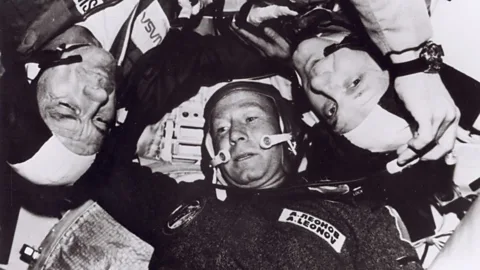 Nasa
NasaIn 1975, a meet-up between American and Soviet spacefarers in orbit showed that the superpowers could work together. Its positive effects eventually led to the International Space Station (ISS).
At just 33, Glynn Lunney was one of Nasa's most experienced flight directors. By 1970, he had been at the heart of the action for everything from the Apollo capsule's first orbit to Neil Armstrong's first footsteps on the Moon.
Months after helping to lead efforts to save the crew of Apollo 13 when their spacecraft exploded, Lunney was preparing for his next lunar mission. Then he got a phone call from his boss, head of mission control, Chris Kraft.
"He said 'Glynn, start getting ready to go to Moscow, you're going to be there in a couple of weeks'," said Lunney. "It was an out-of-the-blue complete surprise, a stunner to me."
Having devoted his career to winning the space race against the Soviet Union, Lunney was now expected to lead a team to work alongside his Cold War opponents on a joint mission: the Apollo-Soyuz Test Project. The aim was to dock a US Apollo capsule and Soviet Soyuz spacecraft in orbit. Realising that plan would take Lunney the next five years.
Lunney died in 2021, but I was fortunate enough to interview him in 2012 for a BBC radio programme on the Moon landings. We met in Houston's famous Apollo Mission Control Room. The retired flight director sat beside me in his old chair – looking down over dark consoles and the blank main display screens. At the time (it has since been restored), the room felt neglected, the missions a distant memory.
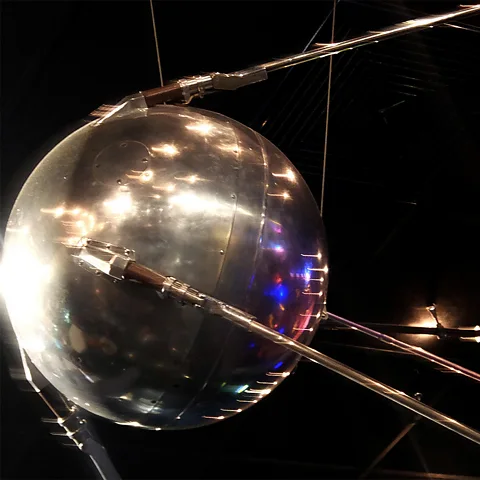 Alamy
AlamyOur conversation was meant to be about the challenge of landing on the Moon, questions he had answered numerous times before. But once Lunney got talking about Apollo-Soyuz, it was clear that this rarely discussed mission was a career highlight.
"I viewed myself as having gone from a Cold War warrior, in terms of getting our programme to the Moon first, to one who was sent to try to see what we could do to cooperate [in space]," he said. "I was just 33 years old when I went to Moscow for the first time, representing the United States and I was thinking, 'Wow!'"
The Soviet Union and United States had been competing in space since the launch of Sputnik-1 in 1957. But the idea of the world's two superpowers working together did not come completely out of the blue.
"There were efforts for many years to find collaborative programmes between the United States and the Soviet Union in space," says Teasel Muir-Harmony, curator for Apollo and Apollo-Soyuz exhibitions at the National Air and Space Museum in Washington DC.
"There was an agreement [about exchanging meteorological data] signed between the US and the Soviet Union in October of 1962, and if you know about October of 1962, it was also the Cuban Missile Crisis when we came closer to nuclear war than ever before in history," says Muir-Harmony. "The space race was always this combination of cooperation and competition."
By the 1970s, the Nixon White House was keen to reduce international tensions with the Soviet Union led by Leonid Brezhnev (the administration also opened-up dialogue with communist China) so Apollo-Soyuz was important diplomatically. But the endeavour had a very practical purpose – if spacecraft from different nations could dock with each other, they might be used to save stranded astronauts.
"The question was, how do you rescue each other's crews in space?" says Kenneth Phillips, curator for aerospace science at the California Science Center. "It was a noble idea that space exploration and collaboration bind us together."
When it came to astronauts assigned to the mission, the symbolism of the selection was also significant. The three-man US crew would include Deke Slayton, one of the original Mercury 7 astronauts. Grounded since 1962 because of a suspected heart condition, Slayton had finally been cleared to fly after watching from the sidelines as the other astronauts pioneered spaceflight and flew to the Moon. The two-man Soviet crew, meanwhile, would be led by Alexei Leonov, the first man to walk in space. If Russia's giant N1 Moon rocket had been successful, Leonov was slated to become the first man to walk on the Moon.
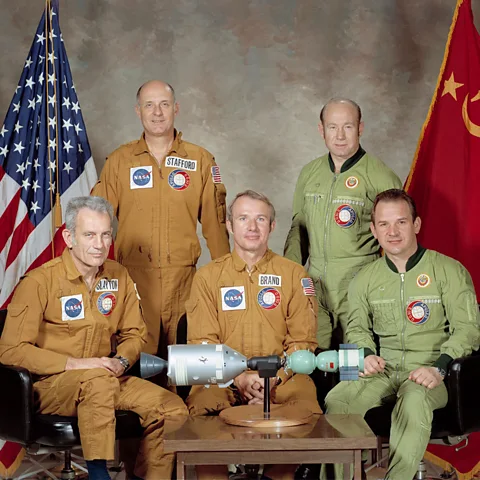 Nasa
NasaThe technical challenge of joining the two spacecraft was considerable. In appearance the spherical Soyuz and conical Apollo spacecraft are very different. Soyuz was only ever designed to operate in low Earth orbit, whereas the Apollo capsule was originally built to fly to the Moon (this particular capsule would have been Apollo 18). Soyuz was mostly operated from the ground, whereas the Apollo astronauts were able to pilot their craft using a state-of-the-art digital computer. Even the air mixture each country's crews breathed in orbit was different.
But perhaps the greater challenge was overcoming the cultural divide and the suspicions that had built up since World War Two between the two Cold War enemies. As the US team headed to Moscow, they were not sure what to expect.
"We soon found out that the people that we were working with were not ogres, they were human beings," command module pilot for the mission, Vance Brand, told my podcast during an interview in 2019. "I had a lot of Russian people that I liked, though the KGB was very active and monitored the cosmonauts closely."
In fact, the rooms the US delegation were staying in at Moscow's Star City were all bugged – Brand's young son even walked in on a KGB listening room – but soon both sides found they were making friends.
"Ultimately many of the people who worked on the programme were surprised by the interest, willingness to compromise and the professionalism of their colleagues," says Muir-Harmony. "The relationship between Alexei Leonov and [Apollo commander] Tom Stafford is a great example – they became really close friends and maintained that friendship throughout their lives."
"Pilots have a lot in common no matter whether they've flown Sabre jets or MiGs," said Brand. "Engineers in the same field can also relate very easily… what we did not talk about was politics and religion."
While the US delegation struggled with learning Russian and getting to grips with drab 1970s-era Moscow, the Soviets cosmonauts had their own culture shock when they visited the States.
"When Alexei Leonov came to the United States, he looked at the highway and saw all these cars with different colours and he wanted to know why the cars come in all different colours," says Muir-Harmony.
On 15 July 1975, the Soyuz with Leonov and flight engineer Valery Kubasov launched from Baikonur in what is now Kazakhstan, followed seven hours later by Stafford, Brand and Slayton in their Apollo from Cape Canaveral. The Apollo carried the specially designed docking adapter that would link the two spacecraft. After orbiting the Earth for two days, on 17 July the spacecraft approached each other.
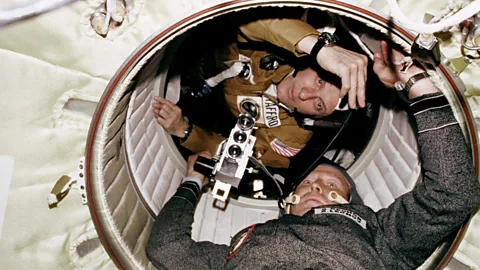 Nasa
Nasa"I first saw them about 400 nautical miles (740km) out," Brand explained. "I aimed the telescope and saw a bright dot in the sky and finally we got very close to them – we could see the solar panels on their spacecraft which looked like wings and so gave it an almost bug-like appearance."
It was a perfect docking. "Then the Americans knocked on the hatch," says Muir-Harmony, "and the Soviets opened it, and they said, 'Who's there?'…which I think is a great joke."
Handshakes and an exchange of gifts followed before US President Ford addressed the crew (Nixon had resigned in August 1974 after the Watergate scandal), expressing his "very great admiration for your hard work your total dedication in preparing for this first joint flight".
After two days together, the spacecraft undocked to return to their homelands. But that wasn't the end of the story.
"Apollo-Soyuz represented a big breakthrough in US-Soviet collaboration," says Svetla Ben-Itzhak, assistant professor of international relations and space security at Johns Hopkins University in Washington DC. "It set the precedent for peaceful cooperation in orbit – this is the moment where space diplomacy really started."
The idea of space diplomacy is that space exploration unites nations with a – mutually beneficial – common goal and that collaboration can then extend back to Earth.
"Science and engineering objectives can bring people together who did not think they necessarily could collaborate productively," says Phillips. "The notion of exploration is something that we can all understand."
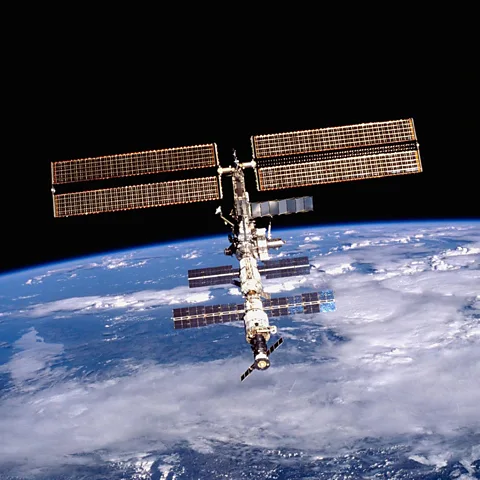 Nasa
NasaApollo-Soyuz led to further cooperation between the superpowers and, with the fall of the Soviet Union, that relationship became closer still. In the 1990s, Space Shuttle missions flew to the Russian space station Mir – with crews from both countries living and working together for months on end. It was followed by the International Space Station (ISS), a collaborative effort between 14 countries with the US and Russia at its heart.
Even since Russia launched its full-scale invasion of Ukraine in 2022, Russians, Americans and Western allies continue to work together in orbit on the ISS.
"It is absolutely amazing that this cooperation in space aboard the International Space Station continues, even when tensions on the ground have intensified and sanctions imposed against Russia, including in the space sector," says Ben-Itzhak. "Yet 450km (280 miles) above the Earth, we are still collaborating and working together."
To some extent Russia and the US have no choice but to work together. The ISS is designed so the various national segments are interdependent. If one partner pulls the plug, then the station will fail. The ISS partners are essentially trapped in a toxic marriage, although on the station itself all the astronauts reportedly get along fine.
Ben-Itzhak studies what she has termed "space blocs" – the emerging groupings of space nations. Right now, as countries plan a return to the Moon, it looks like the US and Russians will soon go their separate ways. Russia will likely side with China, and Western nations – including Europe and Canada – will coalesce around the US. But there are also other blocs emerging, including Arab, African and Asian nations (India, for example, is fast becoming a significant space power).
So, could the lessons learnt from the Apollo-Soyuz Test Project one day apply to the Moon? Both sides of this new space race are eyeing-up establishing bases at the lunar South Pole, even at the same crater. So, can Ben-Itzhak imagine handshakes and knock-knock jokes on the lunar surface?
"Right now, I'm sorry to say it is very unlikely," she says. "It's actually worse than that… the Artemis Accords is an international agreement establishing norms of behaviour on the lunar surface, including peaceful exploration, transparency, emergency assistance and preserving the common heritage including the footprints left by the astronauts."
"It's been accepted by 55 countries but not by China or Russia."
As for Apollo-Soyuz, when I have mentioned to people that I'm writing this article, few – even in the space business – seem to have heard of it. The two sides of the mission are once again a world apart – both politically and literally. The Soyuz spacecraft is in the private Energia museum near Moscow and the Apollo capsule is now looked after by Phillips at the California Science Center in Los Angeles. He is, however, optimistic for the cooperative future of space exploration.
"There is an international community that is waiting to collaborate in space," Phillips says. "If government structures permit that, then I think we can do some really incredible work together."
As for Lunney, he went on to head up the Space Shuttle programme – America's next great space adventure. But, 50 years on, his leadership of Apollo-Soyuz deserves to be remembered for changing forever the way rival nations can learn to live and work together in space.
--
If you liked this story, sign up for The Essential List newsletter – a handpicked selection of features, videos and can't-miss news, delivered to your inbox twice a week.
